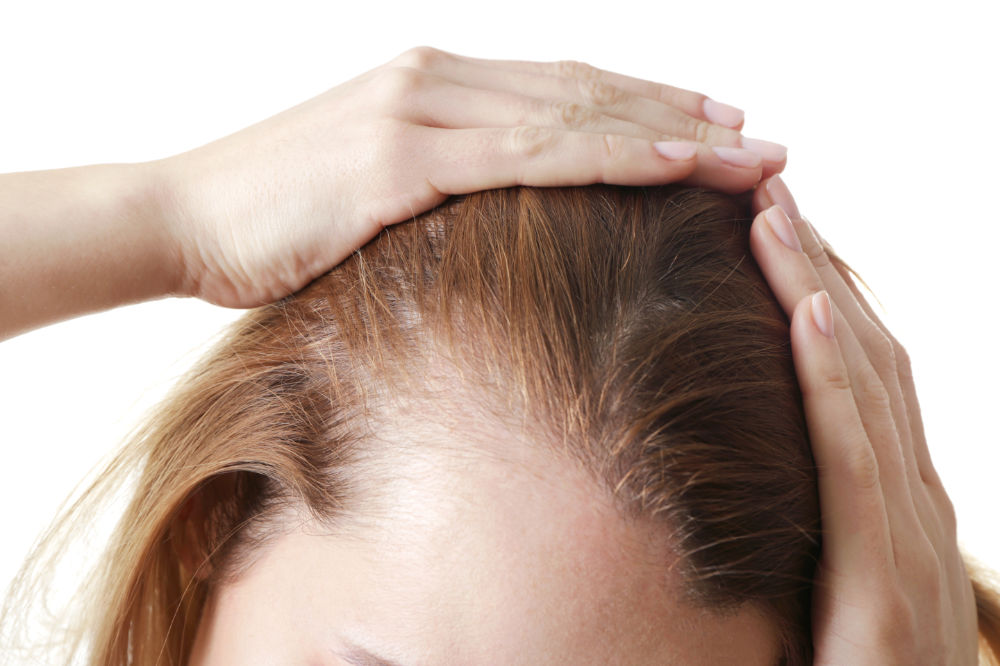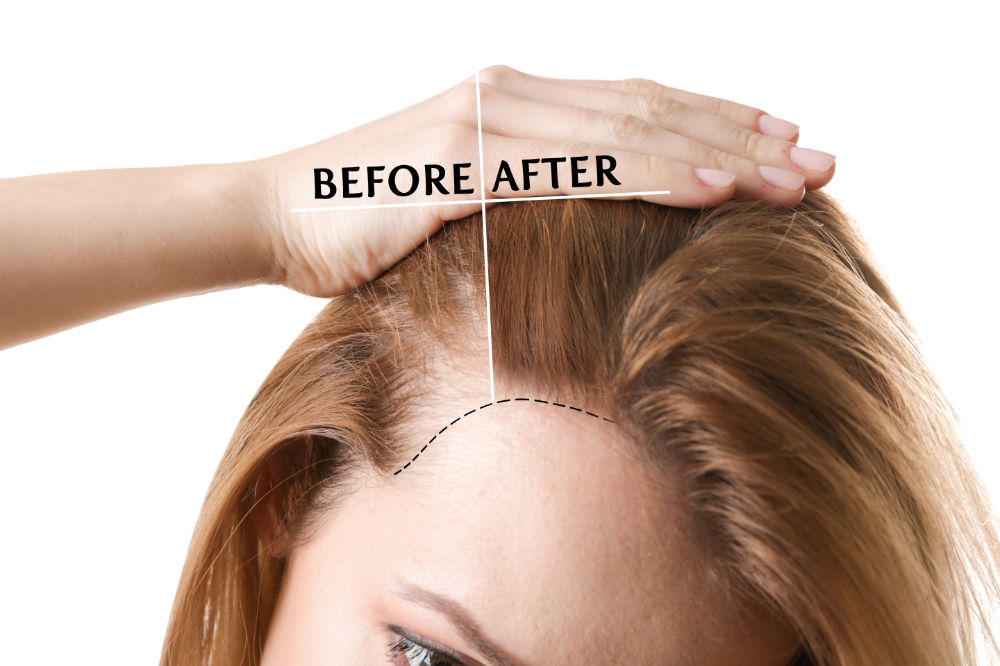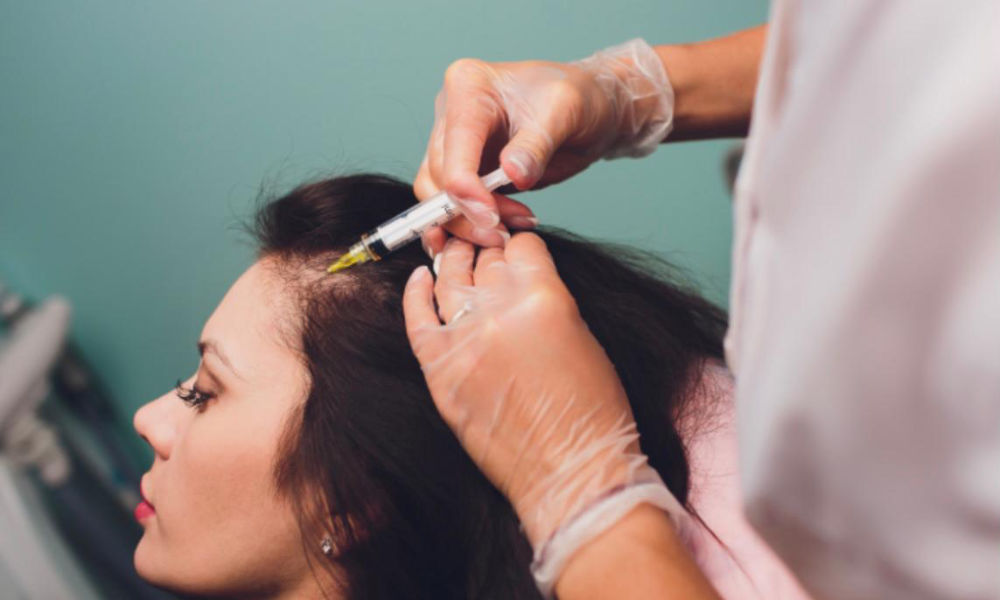While female pattern baldness, or female androgenetic alopecia, is not as common as male pattern baldness, the condition can be no less devastating. The condition is normal for more than half of all women, and while losing your hair is relatively harmless, your confidence is where it tends to receive the most damage.
Fortunately, if you get an early diagnosis for female pattern hair loss, you’re much more likely to prevent future damage. In this article, we’ll be walking through some of your options for treating hair loss in women. But first, a little about the condition itself.
What Is Female Pattern Baldness?
Female pattern baldness – or female pattern hair loss (FPHL) – is very similar to the male version of the condition; the only difference between the two is that men tend to experience a different “pattern” of hair loss.
Whereas men tend to bald from front to back, female pattern hair loss can happen more unpredictably, such as at the temples or part. This is sometimes called the “Christmas tree pattern.”
Additionally, while some men with male pattern baldness progress to an entirely bald scalp, most women do not. Instead, hair thinning is much more common in women and rarely progresses to total baldness.
Female pattern baldness tends to be more common in women over 50, especially after menopause, due to changes in natural hormonal balances. While natural female pattern baldness is harmless, you should always see a doctor or dermatologist as soon as possible to rule out any other potential causes.
Causes and Symptoms

As we mentioned above, menopause and age are very common causes of female pattern baldness. However, other things can contribute to the condition, so keep an eye out for any of the following early warning signs.
Genetics
Unfortunately, female pattern baldness is a proven genetic condition. While we don’t yet understand all of the genes that contribute to early hair loss, you are more likely to develop the condition if other women in your family experienced female androgenetic alopecia as well.
Hormones
Multiple hormones can play a role in the development of hair loss in both genders. The hormone androgen, for example, is often thought to be responsible for some amount of hair loss. Too much or too little androgen in your body can cause changes in your hair growth.
Too much androgen, for example, often results in additional body hair growth on skin appendages as well as diffuse thinning of scalp hair. Other hormones, especially male sex hormones, can contribute to this trend, which is why it affects women less than men.
Keep in mind that hormone imbalances, when not involved with menopause, can sometimes be a symptom of more serious underlying conditions. Polycystic ovarian syndrome (or polycystic ovary syndrome), for example, is a condition that produces hormonal imbalances that can cause hair loss.
Similarly, thyroid conditions or tumours can also be a root cause of these hormonal imbalances. If you’ve noticed more severe acne than usual, you grow hair on your face or abdomen where it has not before, or you’ve had increased hair shedding, be sure to ask your doctor about the screening processes, such as blood tests or scalp tests, for these conditions.
Medical Conditions
Some medical conditions can contribute to hormone fluctuations that cause hair loss. However, some non-hormonal medical conditions, such as alopecia areata, can also cause female pattern baldness.
Alopecia areata is an autoimmune condition that makes the body attack its own hair follicles, eventually leading to female hair loss. Diseases and infections that put the body under a significant amount of stress, such as surgery or a very high fever, can affect hair follicle integrity as well.
Medications and Treatments
Unfortunately, some medications or health treatments can lead to temporary or permanent hair loss. Chemotherapy, for example, as well as other cancer treatments can lead to hair loss in both men and women of all ages.
Smoking
While smoking does not necessarily cause hair loss directly, studies have shown that smoking may be one of many risk factors that can increase your likelihood of developing female pattern hair loss later in life.
Nutritional Deficiency
Many nutritional deficiencies can cause hair loss or just unhealthy hair in general. Iron deficiency, for example, can be a large contributor to hair loss, especially in women who experience heavy periods. Other medical or dietary conditions that affect nutrition levels are possible contributing factors.
Treatment Options to Stimulate Hair Growth

Fortunately, in this day and age, you have many options available to treat female pattern baldness, especially if you begin treatment early. Even thinning hair and completely missing hair patches are treatable – if not completely curable – with the options we have today.
Most treatments for female pattern alopecia focus on slowing down hair loss, but some also restore hair growth. Select an option that will work best for what you need.
Platelet-Rich Plasma

Platelet-rich plasma therapy, or PRP, is a relatively new medical procedure that can restore health to various areas of the body and has shown enormous promise as an effective solution for hair loss. Drug administration happens by both micro-needling the entire scalp and injecting platelets extracted from the patient into problem areas.
PRP therapy is thought to be effective because the nutrient-rich plasma provides white blood cells, growth factors, and proteins that can thicken hair, boost hair volume, and fight excessive hair loss. Additionally, PRP therapy is easy and relatively inexpensive, and because the PRP is extracted directly from the patient’s body, side effects are extremely mild.
Patients often have no downtime at all from the medical treatment and usually no discomfort, either. This treatment works by increasing blood flow to the hair shaft and encouraging new hair growth. The new growth often results in thicker hair and a stronger hair cycle.
Hormonal Therapy
If your female pattern hair loss originates from a hormonal imbalance, it follows that the best way to treat the issue is to rebalance your body’s hormones. Several drugs exist to block the overproduction of the androgen responsible for androgenic alopecia, including:
- Cyproterone
- Finasteride
- Flutamide
- Spironolactone
These medications can be taken orally to help reduce hair growth. Medications like spironolactone can also be combined with minoxidil at low doses to help fight female pattern baldness even more effectively.
Minoxidil
Minoxidil is a common medication used to slow and stop hair loss in women. Patients can take the drug as low-dose oral minoxidil or in a cream, and while it does have some side effects, treatment tends to be effective. However, while it is effective for slowing female pattern hair loss, Minoxidil only helps stimulate hair regrowth in about one of every five patients.
Hair Transplant
If all else fails (or if you just want to get it over with), hair transplantation can be an effective way to regrow hair. If you try to stimulate hair growth and fail, a hair transplant can be a great way to bring yourself back to “square one,” so to speak.
However, this may not be an option for everyone, depending on how much hair you have left and how healthy it is.
Laser Therapy
Laser treatment is an emerging therapy for female pattern hair loss. While these laser light treatments have only recently been approved by the FDA, they show promise to improve hair density and promote the growth of new hair. These lasers come in helmets, combs, and several other administration methods to treat everything from a receding hairline to a bald patch.
Self-Care
If you don’t take proper care of your body, then any hair loss treatment you attempt will ultimately fail. After all, the best way to treat any medical issue is to identify and fix the underlying problems first. Therefore, be sure to start with yourself before you attempt any other treatments.
For example, ask yourself these questions: Do I take care of my hair properly? Am I ingesting the proper nutrients and healthy foods that my hair and skin need to thrive? Could any of my daily habits or activities (such as smoking or certain high-tension hairstyles) be contributing to my hair loss?
FAQs
Do you have any lingering questions about female pattern baldness or its treatments? If so, we may be able to answer them in the FAQs below.
Is female pattern hair loss preventable?
Because it’s difficult to tell when and where future hair loss will start, it’s very difficult to prevent it entirely. However, even though hair loss tends to enter the picture after age 50, it’s important to care for your hair and your body both before and after that age. After all, keeping your body healthy is one of the most effective ways to treat hair loss.
Taking care of your hair separately from your body can be helpful, too. Make sure to look up hair care tips for female pattern baldness if you notice that you lose hair from certain activities.
Can I reverse female pattern baldness?
While there is no “miracle cure” for female pattern baldness, working one-on-one with an experienced doctor or dermatologist is an excellent way to find a solution for your condition. Even if you and your doctor can’t find a way to reverse it, lots of easy, inexpensive, and temporary fixes exist out there that can help fight a negative body image, such as wigs, spray products, volumizers, and more.




